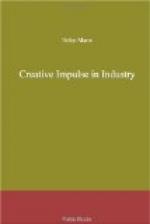Many educators appreciate the lack of content provided by industrial school systems as, with weak emphasis, they undertake to embroider the system with history and aesthetics of textiles or other raw material which the workers handle, or introduce the story of past processes. As this furbishing of impoverished industry fails dismally to add content, it succeeds in emphasizing the actual poverty that exists.
Dr. Stanley Hall makes the suggestion that books on the leading trades should be written to stimulate the interest and intelligence of the young who are engaged in industry or preparing to become the wage earners of the trades. In speaking of “the urgent necessity now of books on the leading trades addressed to the young,” he says;[A] “The leather industry, particularly boot and shoe manufacture, is perhaps the most highly specialised of all in the sense that an operator may work a lifetime in any one of the between three and four score processes through which a shoe passes and know little of all the rest. Now the Shoe Book should describe hides and leathers, tanning,—old and new methods, with a little of the natural history of the animals, describe the process of taking them, of curing and shipping, each stage in the factory, designating those processes that require skill and those that do not, and so on to packing, labeling and shipping, with descriptions showing the principles of the chief machines and labor-saving devices, at any rate so far as they are not trade secrets; it should include a glance at markets, prices, effects of business advance, depression and strikes, perhaps something about the hygiene of the foot, about bootblacks and what is done for them, history of the festivals and organizations from St. Crispin and the guilds down, tariffs, syndicates, societies, statistics, social conditions in shoe towns, nationality of operatives,—all these could be concisely set forth to show the dimensions, the centers of interest, the social and commercial relations of the business, etc. What is not yet realized is that all these things could and should be put down in print and picture, almost as if it were to be issued as a text-book or a series of them; all of this could




